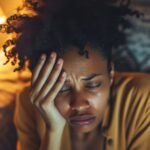Reviving Passion: Exploring Causes and Solutions for Low Libido
Paz Etcheverry, MS, PhD
May 2024
Low libido means having a low appetite for sex and, just like vaginismus, it falls under the category of sexual disorders that afflict women. When coupled with elevated stress levels attributed to diminished libido, the condition is known as hypoactive sexual desire disorder.[19]
Low sex drive is the most common sexual issue reported by women.[18] Research reveals that low sexual desire impacts 26 out of every 100 premenopausal women,[10] while the prevalence increases to 52 out of every 100 menopausal women in the US.[19] And while low sex drive can affect women of all ages, studies suggest that younger women find low libido to have a greater lifestyle effect.[1]

There are several causes for low libido.
- Age is one major factor that can contribute to low libido. Starting at the age of 45, there is a decrease in sex hormones, primarily estrogen and testosterone. Low estrogen levels lead to vaginal dryness, which can make penetrative sex particularly painful, a condition known as dyspareunia. Furthermore, low estrogen levels lead to reduced sensitivity in the genital area, which can impede a woman’s ability to actively respond to sexual expression and cues.[1]
- Testosterone is a major driver of sex as it enhances sexual desire and behavior. By the time women reach menopause, between ages 40 and 60, their testosterone levels are almost a quarter of what they used to be during their 20s.[1] Weight gain and depression can also decrease libido.[17] Relationship difficulties can have a considerable effect on sexual desire, along with emotional stress, the health of the partner, and family conflicts. Moreover, surgical procedures (like oophorectomies, which involve removing one of the two ovaries responsible for estrogen and testosterone production), health conditions, and certain medications such as SSRIs (selective serotonin reuptake inhibitors), can contribute to a diminished libido. These factors may result in the absence of sexual fantasies and a reduced desire for sexual activity.[1][10]
Treatment options for this condition include hormonal treatments and pharmaceutical drugs.
Estrogen
Possible options are oral and local estrogen, such as patches, creams, and rings inserted in the vagina. A caveat with oral estrogen: they lower levels of testosterone, which we know is a major driver of sexual desire. Hence, local estrogen options, which have minimal effects on testosterone levels, might be more suitable. Vaginal moisturizers, as well as water, oil, or silicone-based lubricants, can be used when vaginal dryness is suspected.[10]
Testosterone
Oral testosterone is not an option for women because of the effects it has on blood lipid levels. Instead, patches are recommended. Frequent adverse effects associated with testosterone patches include a rise in body hair or hirsutism (observed in 7% compared to 5% in controls), acne (reported in 9% compared to 7% in controls), and irritation at the patch site affecting up to 30% of participants. These effects resolve, however, following discontinuation of treatment.[10] Additionally, there are testosterone creams and gels that, when applied to the upper thighs, abdomen, and forearms, can enhance sexual desire without significant side effects,[6][7][16] although the risk of acne and hirsutism remains possible.
Tibolone
For menopausal women, tibolone may be a beneficial treatment option.[5][8] As a synthetic steroid, tibolone is marketed as hormone replacement therapy. However, there are concerns regarding the potential risk of stroke in older women using tibolone, despite its positive effects on breast cancer, fracture risk, and possibly colon cancer.[4]
Dehydroepiandrosterone or DHEA
Touted as the “elixir of youth”, DHEA is converted in various body tissues into estrogen and testosterone.[3] DHEA is available over-the-counter, but its safety remains unclear.[11]It is also unclear to what extent DHEA is beneficial, particularly for libido and general well-being..[12][20]
Flibanserin
Flibanserin is a drug that selectively influences neurotransmitter pathways that are associated with sexual desire.[10]In studies, a daily dose of 100 mg improved sexual desire in women.[9][15] However, the drug has some unwanted side effects such as nausea, dizziness, fatigue, and insomnia.[2]
Bupropion
Bupropion is a drug that enhances sexual desire.[13] Psychiatrists commonly recommend bupropion for the treatment of SSRI-induced low libido due to studies demonstrating its positive impact on desire, arousal, lubrication, orgasm, and satisfaction in women with SSRI-induced sexual dysfunction.[10][14]
There are multiple causes of low libido that may be physical, emotional, medical, or due to relationship conflicts. Treatment options are available to reignite sexual desire. Work with a trusted healthcare provider to explore the various options available and get back to feeling like you.
References
[1] AlAwlaqi, A., Amor, H., & Hammadeh, M. E. (2017). Role of hormones in hypoactive sexual desire disorder and current treatment. Journal of the Turkish German Gynecological Association, 18(4), 210–218. https://doi.org/10.4274/jtgga.2017.0071
[2] Baid, R., & Agarwal, R. (2018). Flibanserin: A controversial drug for female hypoactive sexual desire disorder. Industrial Psychiatry Journal, 27(1), 154–157. https://doi.org/10.4103/ipj.ipj_20_16
[3] Buffington C. K. (1998). DHEA: elixir of youth or mirror of age?. Journal of the American Geriatrics Society, 46(3), 391–392. https://doi.org/10.1111/j.1532-5415.1998.tb01062.x
[4] Cummings, S. R., Ettinger, B., Delmas, P. D., Kenemans, P., Stathopoulos, V., Verweij, P., Mol-Arts, M., Kloosterboer, L., Mosca, L., Christiansen, C., Bilezikian, J., Kerzberg, E. M., Johnson, S., Zanchetta, J., Grobbee, D. E., Seifert, W., Eastell, R., & LIFT Trial Investigators (2008). The effects of tibolone in older postmenopausal women. The New England Journal of Medicine, 359(7), 697–708. https://doi.org/10.1056/NEJMoa0800743
[5] Davis S. R. (2002). The effects of tibolone on mood and libido. Menopause (New York, N.Y.), 9(3), 162–170. https://doi.org/10.1097/00042192-200205000-00004
[6] El-Hage, G., Eden, J. A., & Manga, R. Z. (2007). A double-blind, randomized, placebo-controlled trial of the effect of testosterone cream on the sexual motivation of menopausal hysterectomized women with hypoactive sexual desire disorder. Climacteric: The Journal of the International Menopause Society, 10(4), 335–343. https://doi.org/10.1080
[7] Goldstat, R., Briganti, E., Tran, J., Wolfe, R., & Davis, S. R. (2003). Transdermal testosterone therapy improves well-being, mood, and sexual function in premenopausal women. Menopause (New York, N.Y.), 10(5), 390–398. https://doi.org/10.1097/01.GME.0000060256.03945.20
[8] Kamenov, Z. A., Todorova, M. K., & Christov, V. G. (2007). Effect of tibolone on sexual function in late postmenopausal women. Folia Medica, 49(1-2), 41–48.
[9] Katz, M., DeRogatis, L. R., Ackerman, R., Hedges, P., Lesko, L., Garcia, M., Jr, Sand, M., & BEGONIA trial investigators (2013). Efficacy of flibanserin in women with hypoactive sexual desire disorder: results from the BEGONIA trial. The Journal of Sexual Medicine, 10(7), 1807–1815. https://doi.org/10.1111/jsm.12189
[10] Maclaran, K., & Panay, N. (2011). Managing low sexual desire in women. Women’s Health (London, England), 7(5), 571–583. https://doi.org/10.2217/whe.11.54
[11] Omura Y. (2005). Beneficial effects and side effects of DHEA: true anti-aging and age-promoting effects, as well as anti-cancer and cancer-promoting effects of DHEA evaluated from the effects on the normal and cancer cell telomeres and other parameters. Acupuncture & Electro-therapeutics Research, 30(3-4), 219–261. https://doi.org/10.3727
[12] Panjari, M., & Davis, S. R. (2007). DHEA therapy for women: effect on sexual function and wellbeing. Human Reproduction Update, 13(3), 239–248. https://doi.org/10.1093/humupd/dml055
[13] Razali, N. A., Sidi, H., Choy, C. L., Roos, N. A. C., Baharudin, A., & Das, S. (2022). The Role of Bupropion in the Treatment of Women with Sexual Desire Disorder: A Systematic Review and Meta-Analysis. Current Neuropharmacology, 20(10), 1941–1955. https://doi.org/10.2174/1570159X20666220222145735
[14] Segraves, R. T., Clayton, A., Croft, H., Wolf, A., & Warnock, J. (2004). Bupropion sustained release for the treatment of hypoactive sexual desire disorder in premenopausal women. Journal of Clinical Psychopharmacology, 24(3), 339–342. https://doi.org/10.1097/01.jcp.0000125686.20338.c1
[15] Simon, J. A., Thorp, J., & Millheiser, L. (2019). Flibanserin for Premenopausal Hypoactive Sexual Desire Disorder: Pooled Analysis of Clinical Trials. Journal of Women’s Health (2002), 28(6), 769–777. https://doi.org/10.1089/jwh.2018.7516
[16] Singh, A. B., Lee, M. L., Sinha-Hikim, I., Kushnir, M., Meikle, W., Rockwood, A., Afework, S., & Bhasin, S. (2006). Pharmacokinetics of a testosterone gel in healthy postmenopausal women. The Journal of Clinical Endocrinology and Metabolism, 91(1), 136–144. https://doi.org/10.1210/jc.2005-1640
[17] Stanikova, D., Zsido, R. G., Luck, T., Pabst, A., Enzenbach, C., Bae, Y. J., Thiery, J., Ceglarek, U., Engel, C., Wirkner, K., Stanik, J., Kratzsch, J., Villringer, A., Riedel-Heller, S. G., & Sacher, J. (2019). Testosterone imbalance may link depression and increased body weight in premenopausal women. Translational Psychiatry, 9(1), 160. https://doi.org/10.1038/s41398-019-0487-5
[18] Sutherland, S. E., Rehman, U. S., & Goodnight, J. A. (2020). A Typology of Women with Low Sexual Desire. Archives of Sexual Behavior, 49(8), 2893–2905. https://doi.org/10.1007/s10508-020-01805-9
[19] West, S. L., D’Aloisio, A. A., Agans, R. P., Kalsbeek, W. D., Borisov, N. N., & Thorp, J. M. (2008). Prevalence of low sexual desire and hypoactive sexual desire disorder in a nationally representative sample of US women. Archives of Internal Medicine, 168(13), 1441–1449. https://doi.org/10.1001/archinte.168.13.1441 [20] Wierman, M. E., & Kiseljak-Vassiliades, K. (2022). Should Dehydroepiandrosterone Be Administered to Women?. The Journal of Clinical Endocrinology and Metabolism, 107(6), 1679–1685. https://doi.org/10.1210/clinem/dgac130





